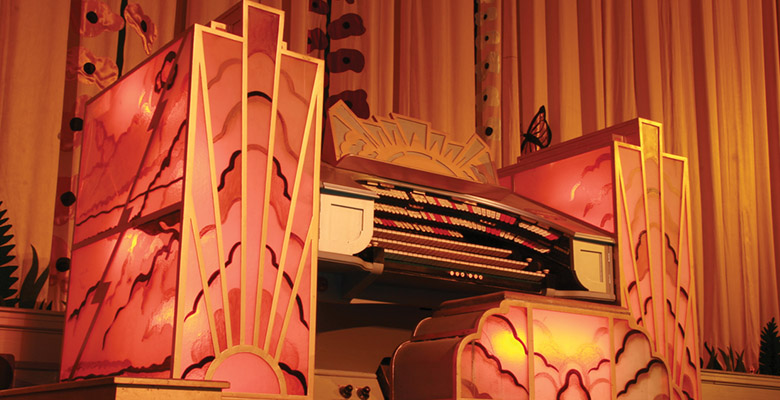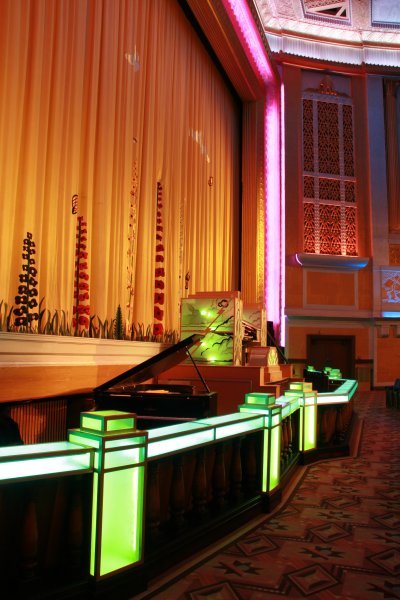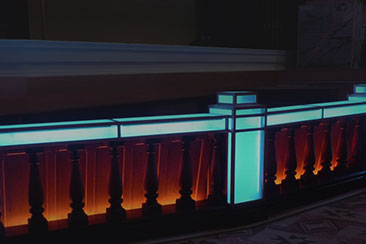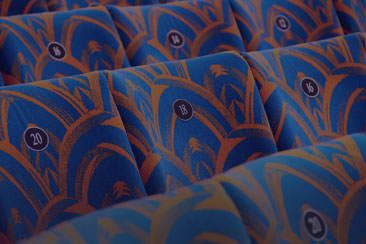Heritage & Restorationthe compton organ
Menu
The Compton Organ
One of the greatest assets of The Plaza is its organ, which has survived intact and in full working order. The Plaza organ was built by John Compton Organ Co. Ltd. and was the first Compton Theatre Organ to be built with sunburst decorative glass panels, illuminated in various colours. It was instruments, like The Plaza organ, that encapsulated the spirit and atmosphere of 1930’s Super Cinema.
The Compton organ is a three manual instrument of special design with a unique 150 stop tab layout which was designed for the Plaza and her sister cinema the Regal in Altrincham by Norman Cocker the resident organist from Manchester Cathedral and Arthur Ward one of the original Directors of the Stockport Plaza when she was built in 1932 plus 42 toe and thumb pistons. It has 11 ranks of pipes situated in 2 chambers, one over the other, concealed behind the decorative grill in the wall to the right
The Plaza is not only Stockport’s home of live theatre and big screen entertainment, but the UK’s last fully intact example of a 1930s super cinema. That gives pride of place to the Plaza’s original Mighty Compton theatre organ, because it was legendary instruments like these, rising majestically out of the orchestra pit, that once encapsulated the spirit of the 1930s super cinemas around the UK.
Only around 5 original theatre organs now remain in functioning UK cinema or theatre buildings and if in use at all, are not frequently seen by audiences. That’s why we’ve been delighted to revive the classic tradition of theatre organ interludes since the Plaza reopened in 2000, thanks to our dedicated team of organists and the organ technicians who have kept this remarkable organ playing.
The Plaza’s Mighty Compton organ was built by the John Compton Organ Company of Willesden, London, hence its name. As the 1932 Plaza Opening Brochure put it, ‘one moment the organist can give the peal of a Cathedral organ and the next he may play a fox-trot with all the rhythmic effect of a modern [1930s] Dance Band’, to which we can add, every kind of melody in between. It was the first theatre organ in Stockport and, according to the Opening Brochure, the first Compton organ to be provided with an illuminated console surround with decorative glass panels. Thereafter illuminated surrounds to different designs became a hallmark of Compton organs, which were also the most numerous make of UK theatre organ.
There are indications that the Plaza organ set out to be special and of high quality. It was designed by Norman Cocker, organist at Manchester Cathedral and at that time also cinema organist at the Plaza’s ‘twin’ cinema (also with a virtually twin organ): the Regal, Altrincham which was destroyed by fire in 1956. His layout of the 3-manual console with 149 stop tabs is now unique to the Plaza.
To this day, audiences often do not realise how the Plaza Compton produces its fantastic sounds and are surprised to learn it is a pipe organ, not too dissimilar from those found in churches. Its 798 pipes are arranged into 11 ranks (or sets), according to the type of sound they make. The pipes range from 2 inches to 16 feet in length. They are laid out in two chambers (rooms), situated, one above the other, behind the decorative grille to the right of the proscenium arch. The organ chambers are enclosed behind shutters which open or close to regulate the volume of sound, controlled by swell pedals on the organ console.
Theatre organs were also famous for their ‘effects’ and the Plaza is no exception. These comprise tonal (effects like glockenspiel or chimes which play a tune), non-tonal (percussions, drums etc), and sounds originally intended for accompanying silent films but still used in the 1930s for special effects (including, for example, ‘wind howl’ or bird whistle). The effects are produced by actual instruments located in the organ chambers and controlled from the console.
The organ is still powered by its original 1932 blower, providing air to blow the pipes, and motor generator which provides current to work Compton’s patent electrical action enabling the organ in the chambers to react to the organist at the console. This system has proved almost indestructible over the Plaza’s 93 years and with the entire organ is a testimony to the quality of the original Compton workmanship.
There are now exciting plans to improve the organ by restoring two ranks of pipes (which create the sounds of orchestral ’Strings’) to the original 1932 specification, thereby creating an improved sound; and repairing the wind reservoirs which supply the appropriate quantity of air (or ‘wind’) for the various parts of the organ. These will help ensure that the much loved musical interludes from our vintage Mighty Compton Organ remain a feature of the Plaza in the 21st century!
David Blake – Director


Support the Stockport Plaza
Help us to continue our restoration project with a one off donation via JustGiving.



